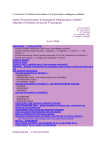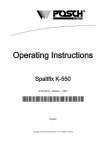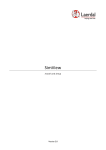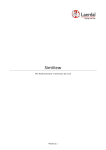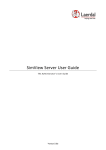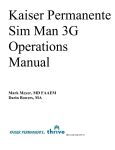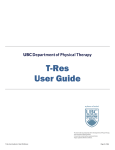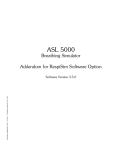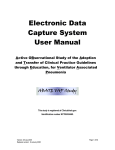Download User Guide for Mobile Clinical Skills Unit
Transcript
Version 1 September 2013 User Guide to Running and Debriefing Scenarios in the Mobile Skills Unit 1 Version 1 September 2013 Introduction Simulation based training allows us to recreate aspects of the real clinical environment to allow our learners to put knowledge into practice or to rehearse application of practical procedures in an environment which is safe for both patient and learner. When done well, simulation can be amongst the most rewarding and enjoyable ways to learn and teach. However, it can be both technologically and educationally challenging and without appropriate planning and delivery can be a harmful experience for both learner and teacher. This brief guide is intended as an aide memoire for facilitators with respect to the basic principles of simulation based education that are covered during the Faculty Development Course run at the Scottish Clinical Simulation Centre. Preparation of the unit Instruction manuals for the SMOTS® equipment and SimMan® are available on the Unit. On the first day of your course please give yourself plenty of time to set up. Setting a Safe Learning Environment Creating a safe learning environment is crucial. At the beginning of the day it is important to set ground rules. Some people find the simulation environment threatening especially the use of digital recording. Clear explanations of the ‘rules of engagement’, codes of confidentiality and of expectations for both faculty and learners should be addressed at the start of any teaching session. Suggested Rules of Engagement • • • • • • • • • The simulation environment is safe not only for the patient but also for your learners. The simulation scenarios are being used for learning and not for assessment of your learners. Scenarios are designed to be challenging and may push your learners outside their comfort zone. This may lead to performance that is less good than you had hoped, this does not necessarily mean that you are not good at your job Some scenarios are more challenging than others so do not compare the performances of your learners In any group, your learners will be involved in some scenarios and will be observers in others. Observers may be asked to contribute during debriefing on things which went well or otherwise bearing in mind that it is much easier to do the scenario as an observer Your feedback during debriefing should be supportive but challenging to optimise learning. All performances will be recorded and the recordings used to allow your learners to reflect on the positive aspects and identify areas of their performance for development. Recordings will not be downloaded (without express written consent of your learners) or used in any other way and the recording will be overwritten on a recording loop in future. If your learners want to stop the scenario , organise how this will be done 2 Version 1 September 2013 Confidentiality Setting the rules around learner confidentiality allows you to build trust at the start of the day. If your teaching sessions are to be used for assessment, this must be stated to your learners along with clear statements of objectives. However, it is more likely that you will be using your scenarios to underpin learning and explore understanding. Setting expectations around feedback is crucial. The following points should be addressed • • Feedback on your learner’s performance will not be given to anyone in their organisation without discussion All your learners need to help maintain this confidentiality for the other course participants. Emphasise to participants the importance of not discussing the performance of other individuals outwith the learning session. In addition, you may want to ask that participants do not discuss details of the scenarios that they see today with anyone outside the MSU as this will help to preserve the learning for others. You may want to consider use of a confidentiality clause as part of your ‘sign-in’ form for the day Simulator Orientation • • • • Manikin introduction - explain what SimMan® SimBaby or other models used in the scenario can and cannot do. What will you actually do eg look for/feel for pulses, breathing & what will you ask about eg. colour temperature etc Orientation using SimMan® is best done in a systematic way working from head to toe through ABCDE approach. This may also be a useful way to reinforce an approach you expect participants to demonstrate during scenarios Fidelity and Expectations – Set an expectation as to what you want your learners to do with equipment use eg cannulation, giving drugs and calling for help – these will be tied to your learning objectives 3 Version 1 September 2013 Planning Before running your learning session you need to be clear Who are you teaching? • • • What is the clinical background of your team participants/learners? What sort of environment do they normally work in? Do they normally work together? What are you trying to teach? • • • • • • If you are not clear about the intended endpoint, the likelihood of getting your learners there is less All teaching sessions should be planned to appropriate learning objectives Learning objectives should be aligned to an appropriate curriculum or KSF for the learner group Each scenario within your teaching session may have different individual objectives which will each contribute to the broader objectives of the whole teaching session. Scenarios should be designed to be relevant to the working environment of your learners All scenarios in a teaching session should be designed, delivered and debriefed to ensure that learning objectives are met. The best measure of success is that learners take home the intended learning from the session objectives. 4 Version 1 September 2013 Avoid the temptation to start your planning with a clinical scenario but remember that the same basic scenario may be used to achieve all sorts of different endpoints depending on the learning objectives that you set at the start. For example you could use a scenario in which the patient has an acute asthmatic attack to address • • • Knowledge and Skills for PAMS which might focus on SEWS scoring and recognition of the unwell patient Knowledge and Skills for Nursing student which might focus on early application of oxygen and use of SBAR for escalation Roles within a multi-professional team, as well as leadership and communication skills in the management of a collapsed patient with asthma. The number of scenarios you use will be influenced by the number of learning objectives, the number of learners in the group, time available and the time required to achieve the agreed objectives. Repetition of learning objectives between scenarios may be a useful way to reinforce some of your key messages, eg demonstrating a systematic approach in the assessment of the critically unwell patient may be an important educational objective for each scenario Learning objectives may address knowledge, technical or non-technical skills or a combination as illustrated below. Depending on the time available limit the number of learning outcomes to 3-4 depending on the experience of the learners involved. 5 Version 1 September 2013 Scenario Title: ASTHMA Target Learners: Learning Objectives : Junior Hospital Doctors Knowledge At the end of this scenario and debriefing the learners will be able to • Demonstrate a systematic approach to the assessment of the critically unwell patient • Recognise and appreciate the presentation of an acutely unwell patient through the interpretation of charts • Complete SEWS and recognise SEWS>4 • Initiate appropriate initial intervention (oxygen and B2 agonist) • Recognise limitations of personal abilities and the need to call for help • Give structured handover using SBAR • Demonstrate clinical leadership • Discuss the importance of prioritisation of clinical tasks in the emergency situation • Demonstrate strategies for appropriate allocation of tasks • Administer appropriate treatment to the asthmatic patient • Support ventilation using BVM Scenario Title: Target Learners: Learning Objectives: ASTHMA Junior Hospital Doctors Technical skills/Psychomotor At the end of this scenario and debriefing the learners will be able to • Demonstrate asystematic approach to the assessment of the critically unwell patient • Recognise and appreciate the presentation of an acutely unwell patient through the interpretation of charts • Complete SEWS and recognise SEWS>4 • Initiate appropriate initial intervention (oxygen and B2 agonist) • Recognise limitations of personal abilities and the need to call for help • Give structured handover using SBAR • Demonstrate clinical leadership • Discuss the importance of prioritisation of clinical tasks in the emergency situation • Demonstrate strategies for appropriate allocation of tasks • Administer appropriate treatment to the asthmatic patient • Support ventilation using BVM Scenario Title: Target Learners: Learning Objectives: ASTHMA Junior Hospital Doctors Non-technical skills / affective At the end of this scenario and debriefing the learners will be able to • Demonstrate a systematic approach to the assessment of the critically unwell patient. • Recognise and appreciate the presentation of an acutely unwell patient through the interpretation of charts • Complete SEWS and recognise SEWS>4 • Initiate appropriate initial intervention (oxygen and B2 agonist) • Recognise limitations of personal abilities and the need to call for help • Give structured handover using SBAR • Demonstrate clinical leadership • Discuss the importance of prioritisation of clinical tasks in the emergency situation • Demonstrate strategies for appropriate allocation of tasks 6 Version 1 September 2013 • Administer appropriate treatment to the asthmatic patient • Support ventilation using BVM • • Having made clear learning objectives, we now need to ensure that scenario is run in a way that will allow them to develop. Resist the temptation to adlib when you are running a scenario or you will quickly lose track of your learning objectives. And remember that just because your participants ‘do well’ does NOT mean that you should ramp up the challenge if these were your objectives. There will be plenty to debrief about anyway and a good performance can be used to demonstrate and highlight sound skills Faculty Roles Ensure everyone in the control room is aware of their roles – even if it is just yourself. Key roles are outlined below (FRIS= Faculty Role player In Scenario). They may all be achievable by one individual but if so they need to be capable of multi-tasking. Control Room Observer Control Room Operator Faculty Plant/FRIS Observe scenario Run patient physiology Usually in the scenario from the outset Bookmark recording Speak as the patient Communicates patient info to the participants eg colour, CRT, BM Take Notes Communicate with the faculty plant(where possible) This person would usually debrief 7 Version 1 September 2013 Briefing Briefing is crucial – have note cards available to brief your “plant/FRIS” and your learners so that they have the information that they need to engage in the scenario. Notes should include: the geographical setting, patient details, handover information and what senior support is available and where. Briefing Note Location You are the FY2 and relief nurse on duty at night in the medical ward of a small district general hospital. Senior help is the on call consultant who is available by phone. Patient Andrew Smith a 22 yr old asthmatic who was admitted 6 hours ago with a chest infection. He is c/o increasing shortness of breath despite using his normal inhalers (salbutamol and ipratropium) Faculty briefing will need to include any prompts or scenario life savers that may be used and therefore faculty members will need to have access to the complete scenario paperwork They may also require access to ‘results’ eg U&Es, ABGs during scenario 8 Version 1 September 2013 Keeping your scenario on track This way, you keep your scenario on track to meet stated learning objectives Learning Objective Scenario State 1 • • Time Expected Learner Actions • Transition Trigger Learning Objective • • • • Scenario State 2 Consider transition triggers – This may simply be ‘time’ controlled (eg deterioration starts 2 minutes into scenario) May be action controlled what are the defined actions which allow scenario to move on? If the participant fails to respond, consider how you might ‘encourage’ them to achieve by using prompts such as physiological prompts eg desaturation ‘Patient’ prompts eg “I can’t breathe” Faculty prompts eg “he had oxygen last time this happened” Bookmark your video for playback Use the video observation chart to note behaviours and actions – note timings, where possible as you may end up with a lot of marks Don’t forget to transition scenario according to transition triggers! -Will you be using preprogrammed trends or ‘driving’ manually? Remember that if you need to use a prompt this may be an important point to explore in your debrief. Ask why? Explore what the deficiencies were 9 Version 1 September 2013 The Debrief The debrief is an integral part of the learning experience and is a valuable opportunity to learn from reviewing actions and from discussion with others. In the debrief, your role is to facilitate learners reflection on their performance during the scenario essentially helping the learners debrief themselves. It should be a positive learning experience. Remember that debriefing should involve critique of behaviours and not of individuals Rudolph et al Debriefing as formative assessment: Closing Performance Gaps in Medical Education Academic Emergency Medicine (2008) vol 15 (11) pp 1010-5 10 Version 1 September 2013 The following summarises ONE model of debriefing which we covered on the MSU Faculty Development Course at the Scottish Clinical Simulation Centre Reaction How did you feel in there? • • • • • • • • • Let the dust settle. Your opening is important - don’t say that the scenario was good if it wasn’t – something along the lines of ‘that looked like a difficult scenario’ would be a truthful way to describe a performance which has not gone well. Avoid using the question “How did it go?” - you will tend to find participants start to talk through the whole scenario and you will lose control quickly. Explore emotional impact - how did your participants feel during the scenario? Did scenario seem realistic? Remember that if your participants engaged well with the scenario then their behaviour is more likely to mirror those seen in clinical practice. Be open about limitations of the simulator especially if these acted as a barrier to your participants engaging Ask about previous experience as this will help to gauge the level of experience and knowledge amongst your participants Use open questions to explore your learners’ thoughts and experiences Involve everyone That felt very real! I've seen a case like that before! 11 Version 1 September 2013 Clarifying scenario successes & challenges • • • • • • • Opportunity for your participants to recount opinions about their performance Start by identifying ‘what went well?’ This question is likely to be met with comment such as ‘the patient survived’. However, patient survival will have been a function of learner action. You might ask them to give you 2 reasons why the patient may have survived eg what was done… Then explore what areas of managing the scenario your learners found challenging / ‘what felt difficult’. This is a more open (and less judgemental) question than ‘what went wrong?’ or ‘what could you do better?’ and is likely to help explore underlying problems in the scenario such as lack of knowledge or skill to complete tasks Good Systematic examination - ABCDE Challenges Drawing up drugs Worked well as a team When to call for help Having a leader SBAR on phone Quick to give appropriate treatment Kardex and paperwork Try to avoid interpretation – commit comments to board as stated so that the board belongs to your participants Avoid adding to the board yourself but encourage all groups to participate – scenario participants and observers. If you have to – only add to the good side NOT to the challenges. It is likely that between a group of learners, they will in fact identify the learning or deficiencies that you want to cover and you can then address them later in the debriefing. Observers should be asked to contribute to these lists. It is worth reminding everyone that “it is always easier to do the scenario from the observers “seats” and questions such as “What were you willing them to do?” may make it easier for your observers to comment on the less positive aspects of performance. 12 Version 1 September 2013 Set the Agenda • The list generated above now forms the basis of participant – focussed learning (if your scenario has been well planned & run, this should also map to the learning objectives that you had planned). • Set the agenda – highlight which areas on the board you are focussing on • If it is clear that knowledge gaps were a problem – identify this and fill them in before embarking on video clips. This may take the form of a “microteach” if desired – this is time efficient and a way to cover knowledge gaps Microteach – Modes of O2 delivery Nasal prongs / cannulae Simple Oxygen face mask Partial rebreather mask Trauma mask (non-rebreather) Venturi mask Nebuliser Bag valve mask Analysis Phase • • • • • • Use 2-3 clips of video playback to cover your objectives – remember your bookmark will be at least 30 seconds after the action you are wanting to focus on so start before this Signpost clearly - “I’m going to show you a short clip of the video now and I want you to watch and look at or think about ….” Let your participants talk Avoid intervening – silence can be a very effective way to make people talk. If not, questions based on observation can open the discussion “What were you thinking there?” Remember that it is important only to critique behaviours – not individuals Use video to explore higher order thinking 13 Version 1 September 2013 Ask questions that you DON’T know the answer to • • • • Avoid asking questions such as “What did you do next?” but rather “What were you thinking/ looking at / what did you make of….?” Use other participants – “Did you know that was what he thought?” “Why do you think you didn’t know that?” etc This may open discussion on communication challenges etc Has debriefing delivered the objectives? Summarise • • • • • • • Take Home v Give Home Reinforce areas of good practice Check that you have covered difficulties highlighted in ‘challenges’ Take home – participants summarise their learning Each participant to say 1 learning or action point to take away Take home messages may be used – these are a useful way to “measure” what participants have learned Or you can use your own Give Home summary of the learning outcomes of the scenarios – you summarise what you set out to achieve Encourage participants to modify their behaviour based on what has been explored So you have achieved Take Home Messages It is good to have a leader The ABCDE approach is crucial SBAR is a good tool to use when phoning for advice Make sure you monitor parameters in your review 14 Version 1 September 2013 Evaluation You may wish to evaluate your own teaching session Remember always to ask your participants to complete the evaluation form for the MSU. Compare take home messages to your Learning Objectives feedback from bottom to top. 15
















